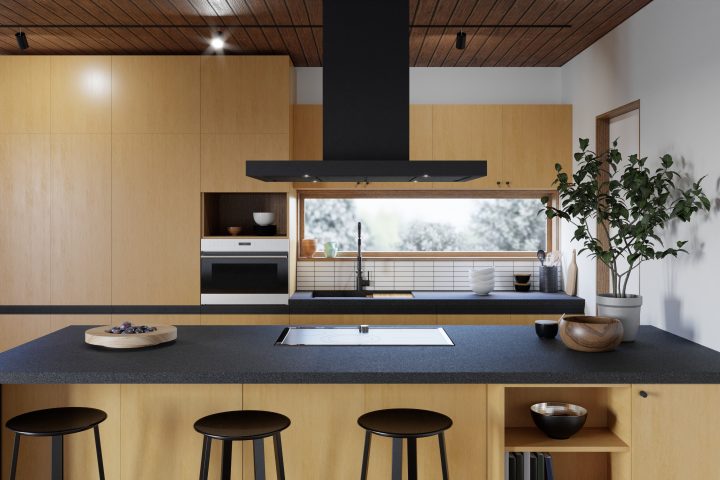The newest extractor hoods on the market guarantee a clean and pleasant living space.
With the growing popularity of open-plan kitchen, living and dining rooms, an exceptional extraction system is more essential than ever for making a pleasing environment in which you can cook, dine and relax at the same time. Lounging and socializing with friends just don’t go well with the smell of frying.
There are many key practicalities to think about when shopping around for the finest extractor for your kitchen space. Some examples would be the voltage of your preferred model, where it should be located, whether you decide for a ducted-out or recirculation design, and most importantly, how your extractor fan looks particularly in an entertaining and living space.
Fortunately, there are a lot of choices to go with any interior you would settle on; from ceiling-mounted models to dazzling pendant extractors and practical downdraft designs, so you won’t need to sacrifice style for function.
Decide your budget
Kitchen extraction aims to remove smoke, steam, grease and horrible cooking odors from your surroundings. Extractors differ hugely in price, costing from £50 up to £3,000 for various highly developed models, so pick your priorities in order for you to decide on a budget.
Select your method of extraction
Choose whether you would have to go for a recirculation or ducted-out extractor, as this will establish where you can or can’t put it.
A recirculation extractor functions by taking the air and passing it through a filter before it exhausts that same air back into the room, rather than by eliminating it outdoors. The filter needs to be altered every few months. Though this may be less effective than a ducted-out model, they however, are quick and easy to install, making them a cost-effective alternative.
Ducted extractors on the other hand, bypass the air through ducting and expel it entirely from the building so you will need access to an external wall. This efficient method of extraction deals with smoke and odors very well.
Calculate the noise
An additional concern when buying an extractor is noise. Every model comes with a dB (decibel) rating, which indicates the noise level related with the particular hood. The faster the speed the noisier the hood will be, however, higher-end models are likely to produce less noise.
Analyze the perfect capacity
The volume of the kitchen is usually multiplied by 10 (length x width x height). The estimated number of air changes required per hour to calculate what capacity extractor you should buy.
It is also essential to consider the type of cooking you’re likely to do. Frying or indoor barbecuing need better extraction than others, we recommend selecting a hood with a minimum airflow of 400m3 per hour if you will be cooking two or three items at a time. Latest system for energy-saving means airflow higher than 650m3 per hour are fixed with a built-in timer.
Obtain the accurate height
Ensure that the extractor has the right height above the hob. You should leave a space of between 65cm and 75cm, if you have an electric, gas or induction hob. Check the width of your chosen extractor as well for it needs to be larger and wider than your hob.
Pick your hood style
Whatever the size of your kitchen or how it’s configured, there’s a certain type of hood that goes well with it. Canopy and chimney hoods were the only extractors available before. But nowadays, choices include ceiling-mounted extractors, downdraft extractors and island extractors. Lately, an extraction was included within the hob itself.
Ceiling extractors
Ceiling extractors are constructed into the ceiling or a bulkhead intended to lower the elevation of the ceiling. The advantage of a ceiling extractor includes no barrier to the cook’s line of sight.
Island or Peninsular extractors
These extractors are built to the ceiling above an island unit. Depending on the location of the island, it might be possible to duct out for optimal extraction, especially if you are designing your kitchen from the beginning, then this requirement can be considered for.
Decorative overhanging extractors
Just like the island extractors; pendant or overhanging extractors are suspended from the ceiling on top of an island. A lot of these are only suitable for recirculation alone, so decide as to whether this will be enough for your kitchen’s needs.
Downdraft extractors
A downdraft extractor rises up out of the worktop when in use, and goes down within the surface when not. The closer you put the extractor to the source of cooking, the lesser chance of the ‘dirty’ air to disperse around the room, which is why it is often built behind or to the side of the hob.
Canopy extractors
Canopy extractors also known as built-in extractors, are assembled into the kitchen cabinetry over your hob making a seamless addition to the kitchen. This is perfect for folks who want a simple look as the extractor doesn’t interfere on the kitchen design.
Deciding on which materials and appliances to buy for your kitchen may be difficult, but with these recommendations it is likely to become a reality.




